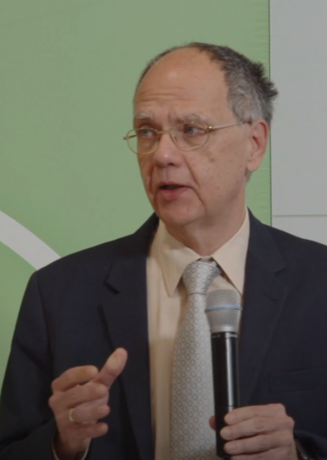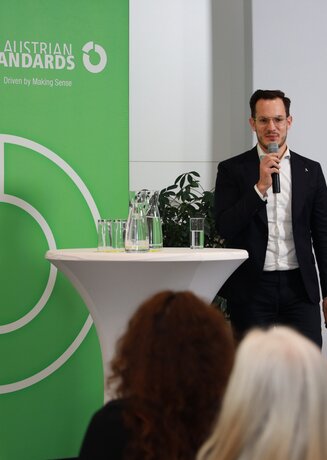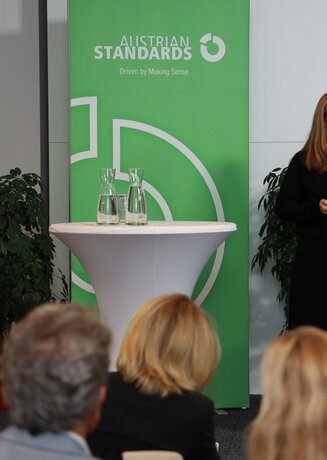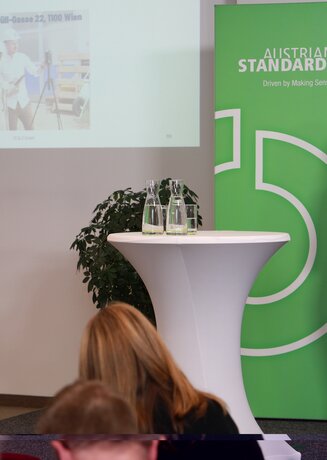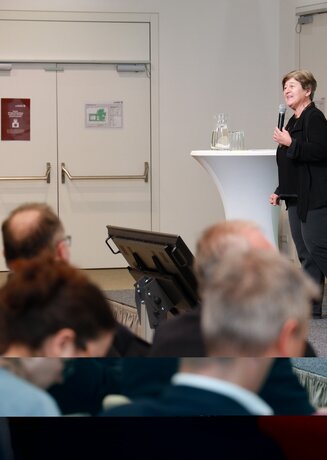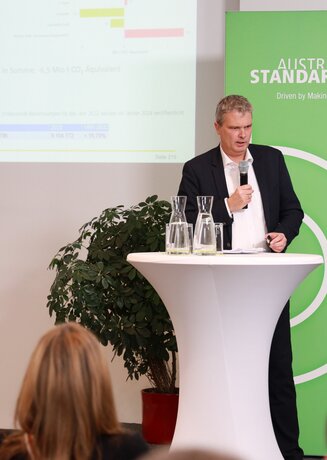6th Annual Conference for Construction
On 29 November 2023, Austrian Standards welcomed numerous experts to the 6th Annual Conference for Construction Law and Construction Standards to define sustainable and resilient solutions for the construction industry. Best-practice examples from real life were not just used to demonstrate hurdles and obstacles to sustainable projects, but also to illustrate perspectives for the future. The delegates agreed that in "stormy" times the construction sector is trend-setting – in terms of technological, social and economic developments. Thomas Pöll, Editor-in-Chief at the trade journal 'SOLID' guided the attendees through the exciting agenda.
Karl Grün, Director Standards Development at Austrian Standards, stressed that the construction sector is a mirror image of the economy and society as a whole. Topics like delivery bottlenecks, a lack of skilled workers, high interest rates and energy costs are huge challenges, which need sustainable, innovative and resilient solutions.
Real-life solutions
Claus Nesensohn from refine Projects AG & refine Austria GmbH, reported in his keynote speech entitled "What does 'Lean and Green' add to the construction sector?" of how sustainability and efficiency in building go hand in hand based on his own experiences. The expert believes that anyone building 'lean and green' can enjoy time savings of around 30% and almost as much in carbon emissions in their construction projects. The main reason why 'lean and green' is still not being applied on a large scale is due to the transparency that the management system requires. But it is worth engaging with the approach because the "waste product" of lean buildings is sustainable preservation of resources and lower costs. The desire for constant improvement is another central point when it comes to resilient solutions. Nesensohn's very practical recommendation is to take seven minutes out every day to work on potential for improvement and to note down key words.
Framework conditions for sustainable building
In her subsequent keynote speech, Karin Fuhrmann, TPA Austria, talked about the EU regulation on taxonomy for sustainable activities and what influence this is having on the construction industry. She was convinced that the EU regulation will prove to be advantageous for "green buildings" and those who work with the regulation from the outset. Even though the taxonomy regulation is still being developed and auditing as well as calculations will be a "Herculean task", it will however be increasingly hard for buildings that don't comply with the regulation to find investors.
Clemens Hecht from the Austrian Economic Chamber, Association of the Austrian Stone and Ceramic Industries, spent some time discussing the matter of existing building stock. There are around two million existing buildings in Austria which will have to be converted and made fit for future climates at some point or another. Given the shortage of skilled workers and in view of rising costs, Hecht advocated for focusing on the actions required in all projects and warned of unnecessarily stringent requirements in regulations and legislation.
Robert Jansche from the Office of the Styrian Provincial Government and Chair of the Board of the OIB spoke about the OIB guideline as well as the revision of the Construction Products Regulation from its schedule to implementation. The OIB guidelines need to be continually revised to reflect new topics, such as electric charging stations or green façades. The 2023 version follows suit. Themed blocks, such as "grey energy" and the "adaptability of buildings", will then also be covered in guideline 7, which has not yet been produced. The OIB plans to pass guideline 7 "Sustainability of structures" in May 2027.
Roman Schremser from ASFINAG Bau Management GmbH reported that decarbonisation and electrification need infrastructure. By 2030, ASFINAG aims to install 1500 electric charging points. Roads, bridges and other traffic infrastructure will also have to be reinforced to cope with the higher weight of electric vehicles compared with their fossil fuel-powered equivalents. Schremser views the Construction Products Regulation in a positive light because it will create legal certainty and transparency. On the whole, we are living through exciting times; Schremser was certain that innovative products, building materials and procedures will open up new opportunities.
Keys and obstacles
After the coffee break, Katharina Bayer from einszueins architektur ZT GMBH reported on her own planning experiences. She seemed convinced that the future of building lies in the existing building stock. Bayer sees the concept of modular projects as the key to needs-based and therefore more sustainable construction. According to Bayer, in order to reach climate targets, existing buildings need to be used smartly and for as long as possible. With new build projects, the fact that today's new building is a raw material for the future must be included in calculations even at the planning stage.
Simone Grassauer from SCALE Umweltberatung GmbH talked during the facts check about renovations that can be part of a closed-loop economy. She is sure that integral, circular planning isn't just needed for new build projects, but is also indispensable for renovations. Grassauer believes that what is still missing for consolidation and renovation to be undertaken in the spirit of a closed-loop economy is a valid database of materials.
Clever renovations are the order of the day
During the podium discussion that followed, Ernst Bach from SOZIALBAU AG, underlined how important energy efficiency and heating costs are to tenants. "Renovating in sympathy with the building" is the order of the day. Matthias Moosbrugger, Rhomberg Bau Holding GmbH, picked up on this thread. Moosbrugger underpinned his conviction that renovation projects could be undertaken faster than is currently the case with the concept of "serial renovations". Then functional and well-proven procedures or tried-and-tested methods and material usages would not have to be planned and approved time and again. Ulrike Rabmer-Koller, Rabmer Group, highlighted that a lot of progress has already been made in the construction sector. By way of example, she pointed to the efficient use of waste water to heat and cool buildings. Annette Scheckmann from STRABAG AG added that for a long time, the question has no longer been whether you want to renovate, but rather when.

Environmental performance of structures and construction products
The next item was a best-practice example, presented by Ursula Schneider, POS architekten ZT -KG. She clearly supported the regulation on taxonomy for sustainable activities, believing that the specifications it contains will help a lot of planners. However, she does see some contradictions and believes that a revision will be necessary. Schneider sees great potential in the certification of entire urban districts in the future. What's more, building shells will make a much greater contribution to the provision of energy in buildings. Schneider is convinced that it lies in the hands of architects and planners to convince their clients of sustainable projects.
Hilbert Focke presented the "Sonnenhaus Österreich" initiative and its "Brick Bauhaus". Mr Focke emphasised that we want to bring the climate neutrality and climate resilience of buildings more to the attention of the general public. According to Focke, topics such as a healthy indoor climate and adequate daylight must not be ignored when certifying buildings.
Life cycle assessment? Yes, but how?
The podium then discussed strategies for practical life cycle assessments in the construction sector. Peter Bauer from the Chamber of Civil Engineers, Architects and Engineers for Vienna, Lower Austria and Burgenland spoke with regret of how the certification of buildings is still a voluntary process and not mandated by law because valuable time is being lost in making all buildings climate-neutral. Verena Macho from FCP Fritsch, Chiari & Partner ZT GmbH, stated that most builders will unfortunately discard certification as soon as the additional costs for the process have been calculated. One of the reasons for why certificates or building in compliance with taxonomy is not prescribed by law is the lack of databases and reference values, says Peter Maydl from TU Graz. Maydl also advocated for "reduced life cycle assessments", which are based on a small number of valid pieces of data. Dirk Jäger from BIG emphasised that, as is the case in Germany and Switzerland, the databases in Austria must be managed by the state in order to ensure their quality. Richard Woschitz from the Woschitz Group added that the construction sector must return to concentrating on the essentials. Woschitz summed things up by saying that sustainable building needs simple methods of calculation, robust data and a new approach of "district-level thinking" as well as pragmatic applications and implementations.
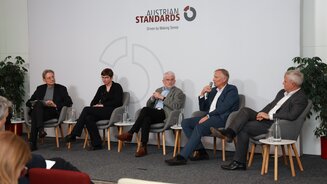
A return to normality
Daniel Thum, Erste Immobilien KAG and Erste Asset Management, then gave a presentation on how the construction sector will develop in the medium term from the standpoint of the financial industry. The record number of completions registered over the last few years will fall dramatically in the near future. Thum believes that the "interest rate-driven super cycle" is over and we are now returning to a "new normality" similar to that from before 2015, a development which he does not regret.
Sandra Bauernfeind, Heimat Österreich gemeinnützige Wohnungs - und Siedlungsges. mbH, Thomas Drozda, ARWAG Holding-AG, and Silvia Hofer from wohnfonds_wien, as well as Isabella Stickler, Alpenland AG. The podium agreed that there is pronounced awareness amongst all stakeholders of the need for sustainable, resilient construction. What we now need are practical specifications, robust reference values and decisive action on the part of politicians. They also agreed that today's challenges, ranging from climate protection to war and the cost of living crisis, open up great potential and huge opportunities, and that the construction sector can and must be a valuable driving force for a sustainable society.




More on the topic
The 6th Annual Conference for Construction Law and Construction Standards took place on 29 November 2023 as part of the "Austrian Construction Dialogue Board – Working together for clear and simple building rules" project.
Download presentations (German only)
- Was bringt Lean und Green dem Bausektor?
Claus Nesensohn | refine Projects AG & refine Austria GmbH - Wie verändert die EU-Taxonomie-Verordnung die Bau- und Immobilienentwicklung? (PDF – 1.2mb)
Karin Fuhrmann | TPA Österreich - Was gilt für Bestandsbauten und wie sollte bei Sanierungsfällen entschieden werden? (PDF – 0.4mb)
Clemens Hecht | Wirtschaftskammer Österreich, Stein- und keramische Industrie, Fachverband - Fokus OIB-Richtlinie & Überarbeitung BauproduktenVO & Fahrplan Umsetzung (PDF – 0.7mb)
Robert Jansche | Amt der Steiermärkischen Landesregierung, Vorstandsvorsitzender des OIB - Fokus OIB-Richtlinie & Überarbeitung BauproduktenVO & Fahrplan Umsetzung (PDF – 1.3mb)
Roman Schremser | ASFINAG Bau Management GmbH - Neubau vs. Sanierung – Planung als Schlüsselfaktor? (PDF – 7.2mb)
Katharina Bayer | einszueins architektur ZT GMBH - Kreislauffähiges Sanieren – wie der Gebäudebestand aufblüht (PDF – 1.6mb)
Simone Grassauer | SCALE Umweltberatung GmbH - Die Dekarbonisierung des Bauwerks – auf dem Weg zum aktiven Energiegebäude (PDF – 8.1mb)
Ursula Schneider | POS architekten ZT -KG - Die Dekarbonisierung des Bauprodukts – auf dem Weg zur klimaneutralen Produktion (PDF – 4.3mb)
Hilbert Focke | Initiative Sonnenhaus Österreich - Die Entwicklung der Baukonjunktur und des Immobilienmarkts (PDF – 1.5mb)
Daniel Thum | Erste Immobilien KAG und Erste Asset Management
More information about the Austrian Construction Dialogue Board (Dialogforum Bau Österreich)
www.dialogforumbau.at
